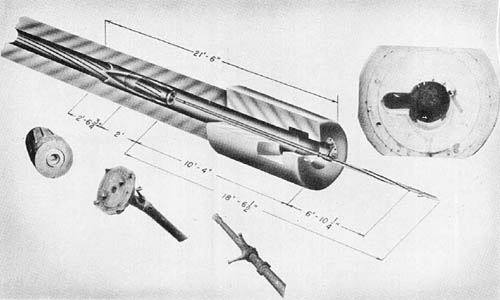
Indexing and ramming the 28 cm prerifled projectile in the German railway gun, 28 cm K5 (E), is accomplished with the aid of the rammer which, by gripping the base of the shell, allows the projectile to be indexed during its final travel through the powder chamber. Fitted centrally in the flat head of the rammer are two claws, reversed to each other and held outwardly by spring tension. A circular undercut recess in the base of the projectile receives these two claws holding the base of the shell against the face of the rammer. Two keyways milled in the periphery of the base of the shell receive corresponding, lugs on the face of the rammer and hold the members in rotation. Four evenly spaced lugs projecting longitudinally from the face of the rammer fit over the sides of the base of the projectile and hold the two in a transverse direction.
The head is fitted by a universal joint to the rammer, the front portion of which is a plain two-inch shaft approximately ten feet long and the rear portion machined with four longitudinal splines set at the same angle as the rifling of the tube. Over the splined portion of the rammer, which is 6 feet, 10/4 inches long, slides a collar fitted with two radially projecting horns set at approximately 75 degrees. The last 16 1/4 inches of the rammer are not splined and the extremity threaded, in all probability to receive a transverse handle. A lever which depresses the claws to release the head from the base of the projectile is fitted to the rear portion of the shaft.
A bracket bolted in the rear face of the breech ring has the function of receiving in two longitudinal keyways, the extremities of the two radial horns of the sliding collar.
In operation, the rammer is held securely to the base of the projectile and the shell is rammed through the powder chamber until the two horns of the sliding collar, in its forward position along the splines, engage in the two matching keyways of the bracket fitted to the rear of the breech ring. At this point, the shell, which still has approximately 2 feet, 6 3/4 inches to travel before the leading edge of the splines engage in the grooves of the rifling, is indexed and during the remaining forward travel of ramming remains indexed by virtue of the sliding collar which being held against rotation causes the rammer sliding through it to rotate at the same twist as the rifling.
The position of the two horns can be adjusted in relation to the body of the collar and once set for a particular gun, no further adjustments are necessary. A scale etched on the spline portion of the rammer indicates the depth of ramming from 2,850 to 4,050 centimeters for the 28 cm K5 (E).
German: p. 312.2 (June 1, 1945)